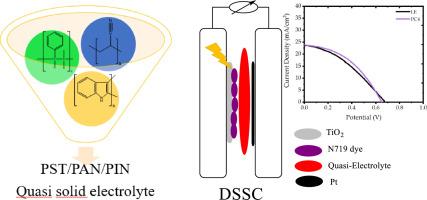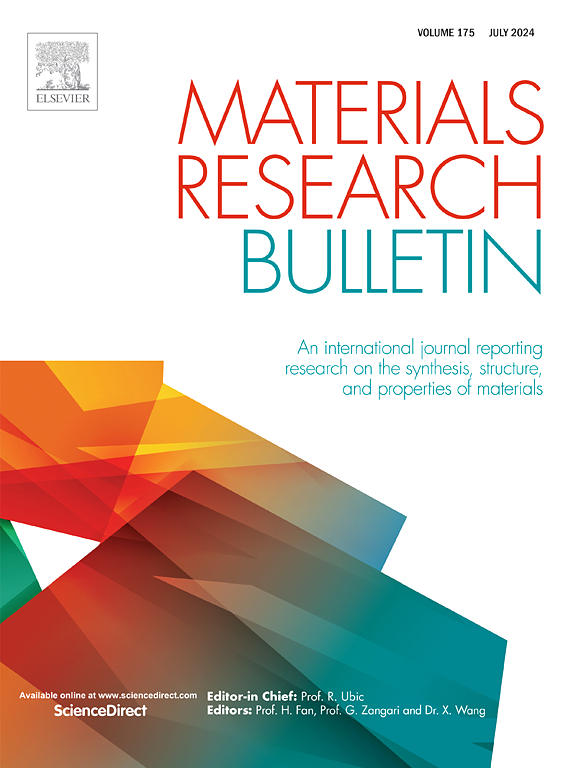Polystyrene/Polyacrylonitrile/Polyindole based quasi solid electrolytes for DSSCs: Boosting both efficiency and stability
IF 5.3
3区 材料科学
Q2 MATERIALS SCIENCE, MULTIDISCIPLINARY
引用次数: 0
Abstract
Recently, the utilization of quasi solid electrolytes has increased to overcome the stability and leakage issues caused by using liquid electrolytes in dye-sensitized solar cells. For this purpose, the novel different amounts of polystyrene/polyacrylonitrile/polyindole based quasi solid electrolytes were prepared and characterized via FTIR, GPC, TGA, DSC and electrochemical procedures. We aimed to develop conductive polymer-based solid electrolytes to be used in DSSCs to improve both solar cell conversion efficiency and stability. The conversion efficiency value of the solar cell using semi-solid electrolyte (PC4) boosted (9.91%) compared to the one using liquid electrolyte (9.74%). Additionally, the solar cells’ stabilities prepared with quasi solid electrolytes are two times higher than solar cells including liquid electrolytes. Therefore, in this study, the potentials of using conductive polymer-based quasi solid electrolytes in DSSCs were investigated and promising results were acquired for future applications.

用于 DSSC 的聚苯乙烯/聚丙烯腈/聚吲哚基准固体电解质:提高效率和稳定性
最近,为了克服在染料敏化太阳能电池中使用液态电解质引起的稳定性和泄漏问题,准固态电解质的使用越来越多。为此,我们制备了不同含量的新型聚苯乙烯/聚丙烯腈/聚吲哚基准固态电解质,并通过傅立叶变换红外光谱(FTIR)、气相色谱-质谱(GPC)、热重分析(TGA)、电化学稳定性测试(DSC)和电化学过程对其进行了表征。我们旨在开发用于 DSSC 的导电聚合物基固体电解质,以提高太阳能电池的转换效率和稳定性。与使用液态电解质的太阳能电池(9.74%)相比,使用半固态电解质(PC4)的太阳能电池转换效率值提高了(9.91%)。此外,使用半固态电解质制备的太阳能电池的稳定性比使用液态电解质的太阳能电池高出两倍。因此,本研究调查了在 DSSC 中使用基于导电聚合物的准固体电解质的潜力,并获得了对未来应用很有帮助的结果。
本文章由计算机程序翻译,如有差异,请以英文原文为准。
求助全文
约1分钟内获得全文
求助全文
来源期刊

Materials Research Bulletin
工程技术-材料科学:综合
CiteScore
9.80
自引率
5.60%
发文量
372
审稿时长
42 days
期刊介绍:
Materials Research Bulletin is an international journal reporting high-impact research on processing-structure-property relationships in functional materials and nanomaterials with interesting electronic, magnetic, optical, thermal, mechanical or catalytic properties. Papers purely on thermodynamics or theoretical calculations (e.g., density functional theory) do not fall within the scope of the journal unless they also demonstrate a clear link to physical properties. Topics covered include functional materials (e.g., dielectrics, pyroelectrics, piezoelectrics, ferroelectrics, relaxors, thermoelectrics, etc.); electrochemistry and solid-state ionics (e.g., photovoltaics, batteries, sensors, and fuel cells); nanomaterials, graphene, and nanocomposites; luminescence and photocatalysis; crystal-structure and defect-structure analysis; novel electronics; non-crystalline solids; flexible electronics; protein-material interactions; and polymeric ion-exchange membranes.
 求助内容:
求助内容: 应助结果提醒方式:
应助结果提醒方式:


